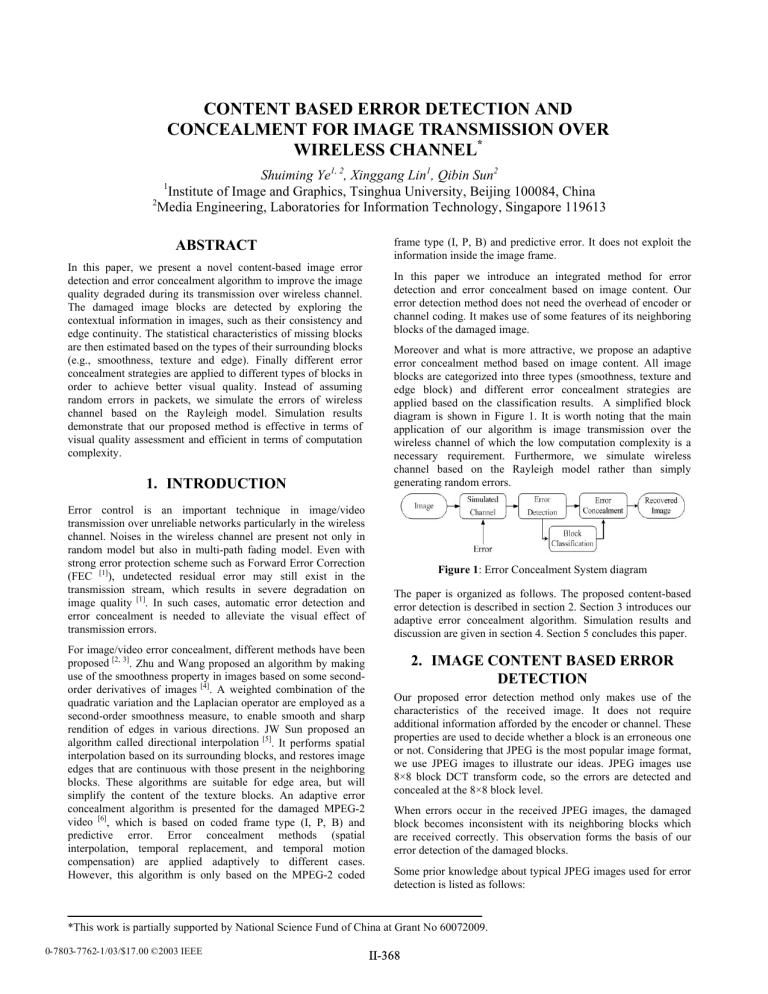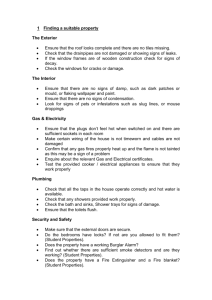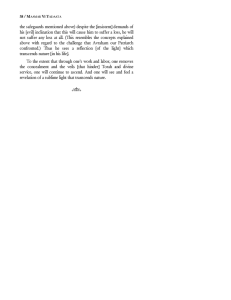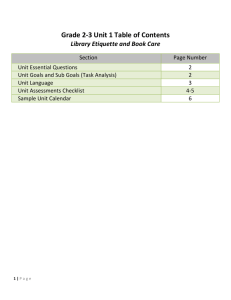CONTENT BASED ERROR DETECTION AND CONCEALMENT FOR IMAGE TRANSMISSION OVER WIRELESS CHANNEL

CONTENT BASED ERROR DETECTION AND
CONCEALMENT FOR IMAGE TRANSMISSION OVER
WIRELESS CHANNEL
*
Shuiming Ye
1, 2
, Xinggang Lin
1
, Qibin Sun
2
1
Institute of Image and Graphics, Tsinghua University, Beijing 100084, China
2
Media Engineering, Laboratories for Information Technology, Singapore 119613
ABSTRACT
In this paper, we present a novel content-based image error detection and error concealment algorithm to improve the image quality degraded during its transmission over wireless channel.
The damaged image blocks are detected by exploring the contextual information in images, such as their consistency and edge continuity. The statistical characteristics of missing blocks are then estimated based on the types of their surrounding blocks
(e.g., smoothness, texture and edge). Finally different error concealment strategies are applied to different types of blocks in order to achieve better visual quality. Instead of assuming random errors in packets, we simulate the errors of wireless channel based on the Rayleigh model. Simulation results demonstrate that our proposed method is effective in terms of visual quality assessment and efficient in terms of computation complexity. frame type (I, P, B) and predictive error. It does not exploit the information inside the image frame.
In this paper we introduce an integrated method for error detection and error concealment based on image content. Our error detection method does not need the overhead of encoder or channel coding. It makes use of some features of its neighboring blocks of the damaged image.
Moreover and what is more attractive, we propose an adaptive error concealment method based on image content. All image blocks are categorized into three types (smoothness, texture and edge block) and different error concealment strategies are applied based on the classification results. A simplified block diagram is shown in Figure 1. It is worth noting that the main application of our algorithm is image transmission over the wireless channel of which the low computation complexity is a necessary requirement. Furthermore, we simulate wireless channel based on the Rayleigh model rather than simply generating random errors.
1.
INTRODUCTION
Error control is an important technique in image/video transmission over unreliable networks particularly in the wireless channel. Noises in the wireless channel are present not only in random model but also in multi-path fading model. Even with strong error protection scheme such as Forward Error Correction
(FEC [1] ), undetected residual error may still exist in the transmission stream, which results in severe degradation on image quality [1] . In such cases, automatic error detection and error concealment is needed to alleviate the visual effect of transmission errors.
Figure 1 : Error Concealment System diagram
The paper is organized as follows. The proposed content-based error detection is described in section 2. Section 3 introduces our adaptive error concealment algorithm. Simulation results and discussion are given in section 4. Section 5 concludes this paper.
For image/video error concealment, different methods have been proposed [2, 3] . Zhu and Wang proposed an algorithm by making use of the smoothness property in images based on some secondorder derivatives of images [4] . A weighted combination of the quadratic variation and the Laplacian operator are employed as a second-order smoothness measure, to enable smooth and sharp rendition of edges in various directions. JW Sun proposed an algorithm called directional interpolation [5] . It performs spatial interpolation based on its surrounding blocks, and restores image edges that are continuous with those present in the neighboring blocks. These algorithms are suitable for edge area, but will simplify the content of the texture blocks. An adaptive error concealment algorithm is presented for the damaged MPEG-2 video [6] , which is based on coded frame type (I, P, B) and predictive error. Error concealment methods (spatial interpolation, temporal replacement, and temporal motion compensation) are applied adaptively to different cases.
However, this algorithm is only based on the MPEG-2 coded
2.
IMAGE CONTENT BASED ERROR
DETECTION
Our proposed error detection method only makes use of the characteristics of the received image. It does not require additional information afforded by the encoder or channel. These properties are used to decide whether a block is an erroneous one or not. Considering that JPEG is the most popular image format, we use JPEG images to illustrate our ideas. JPEG images use
8×8 block DCT transform code, so the errors are detected and concealed at the 8×8 block level.
When errors occur in the received JPEG images, the damaged block becomes inconsistent with its neighboring blocks which are received correctly. This observation forms the basis of our error detection of the damaged blocks.
Some prior knowledge about typical JPEG images used for error detection is listed as follows:
*This work is partially supported by National Science Fund of China at Grant No 60072009.
0-7803-7762-1/03/$17.00 ©2003 IEEE
II-368
• Consistency of known values: It requires that correctly received pixel values not be altered by restoration process, and that restored values lie in a known range
(e.g. 0-255).
• Edge continuity: It requires that edges in the image be continuous across blocks.
• Smoothness: It requires reconstructed samples to be smoothly connected with the adjacent image blocks.
• Error propagation in JPEG Image codec: 8×8 DCT transform and entropy code are adopted in JPEG codecs. When errors occur in a block, they will propagate, typically to the subsequent blocks within the same line. A strong horizontal edge will appear on the top and bottom and a strong vertical edge on the left will appear on this error slice.
Four measures are extracted for error detection. They are: Pixel
Consistency ( PC ), Edge Continuity ( EC ), Horizontal Edge ( HE ) and Vertical Edge ( VE ) on the block border.
We set up a Quasi-error Block Set ( Q ), which includes all blocks of the received image as its elements at the start of the detection operation. A successive procedure including four steps is then used to remove the elements of Q . Finally the blocks remaining in Q are distinguished as damaged blocks. Figure 2 shows the procedure of the detection.
Figure 2 : Error Detection Procedure
Firstly, we use two bytes to store each pixel value of the gray
JPEG image decoded, instead of only using one byte. If one pixel is out of the range of [0,255], then the block it belongs to is judged to be a damaged block and is removed from the quasierror set Q .
Next, at every line of multiple of 8 in image, the Sobel Operator is used to calculate the block horizontal gradients. If the cumulation of this horizontal edge is smaller than threshold T
1
, this block is removed from Q . That is to say, the blocks remaining in Q could be a damaged block.
Thirdly, for each block in Q , we use the Sobel Operator to calculate the sum of vertical gradient of its first left block in the same slice. If this value is smaller than threshold T
2
, this block is removed from Q . The Sobel Operators for horizontal and vertical gradient used are shown below:
S x
=
−
−
−
1
2
1
0
0
0
1
2
1
S y
=
−
1
0
1
2
0
− 0 −
1
0
1
(1)
Finally, we use the method described in paper [5] to detect the edges of the block in Q and edges of its neighbors not in Q . Edge detection is a difficult problem in computer vision. Instead of extracting edge explicitly, this approach estimate edge direction based on gradient, and quantizes it to eight directions. The convolution of the block with a set of 8-directional masks is then calculated. Since several edges may run through the block, we choose the first 3 strongest edges in our algorithm. And then we calculate the quotient of each edge magnitude of the block in Q in one direction, divided by the average of the responsive edge direction of its neighbors not in Q . If the sum of quotients of all direction is smaller than threshold T
3
, the block is also removed from Q .
The blocks remaining in Q are determined to be damaged blocks.
The following error concealment algorithm will only work on those “damaged” blocks.
3.
CONTENT BASED ADAPTIVE IMAGE
ERROR CONCEALMENT
3.1
Algorithm Structure
The procedure of the proposed algorithm is illustrated in Figure
3. Firstly, we use some features extracted from the neighboring blocks of the damaged block to classify this damaged block into three types: smoothness block, texture block and edge block.
Five eigenvalues obtained from statistical measures of its neighboring blocks are selected as features and a Minimum
Distance Weighted Linear Classification (MDWLC) algorithm is adopted for block classification. Different error concealment methods are then applied to each type of blocks: Linear
Interpolation method is used for smooth blocks, DCT Coefficient
Prediction [7]
Interpolation
is used for textural blocks, and Directional
[5] is applied to edge blocks. Some technical details will be given in next section.
Figure 3 : Adaptive Error concealment
II-369
3.2
Error Block Classification
Roughly the areas of natural images could be characterized into three types:
1.
Smooth Area: pixel values usually vary slowly and usually within a small range. Both mean and variance of the gradients are small.
2.
Texture Area: pixel values usually vary in a periodical way. Both mean and variance of the gradients are quite large.
3.
Edge Area: pixel values usually vary significantly and usually within a large range. The mean value of the gradients is between that of type 1 and 2 while its variance value is the biggest among these three types.
Five measures are calculated for block classification. They are:
Pixel Variance ( PV ), Range of Pixel Variance ( RPV ), the
Gradient Mean ( GM ), the Gradients Variance ( GV ), and the
Number of Pixels whose gradient values are within some range
( PN ). After error detection, the correctly received neighboring blocks ( N ) of the damaged block ( M ) are used to extract the PV and RPV of M, by:
Mean ( M ) =
1
Num ( N )
( x ,
∑
y ) ∈ N f ( x , y )
PV ( M ) =
1
Num ( N )
( x , y
∑
[
) ∈ N f ( x , y ) − Mean ( M )] 2
RPV ( M ) = Max ( f ( x , y )) − Min ( f ( x , y )), ( x , y ) ∈ N
(2)
Where Mean ( M ) is the pixel mean of M estimated from N .
Num ( M ) is the element number of N .
We use the Sobel Operator to calculate the gradient ( G ) of the N , and then calculate the GM , GV and PN by:
GM ( M )
=
1
Num ( N )
( x , y
∑
) ∈ N
G ( x , y )
GV ( M )
=
1
Num ( N )
( x ,
∑
y ) ∈ N
[ G ( x , y )
−
GM ( M )] 2
PN ( M )
=
Num {( x , y ) | T
1
<
G ( x , y )
<
T
2
}
(3)
A feature vector ( F ) is composed of these five features and the
MDWLC is used to classify the damaged block, which is shown below.
d
k
( M ) =
5
∑
i = 1
λ
i
( f
i
− u
ki
)
2
k = 1 , 2 , 3
(4)
In the above equation, f i
is the ith value of the feature vector
F ( M ), u ki
is the ith value of the cluster center ( U weighted value corresponsive. The cluster center value ( U k weight value ( image, and d k
λ i k
), and λ i
is the
( M ) is the distance between M and U k
.
) and
) are both from training with a set of standard test
3.3
Error Concealment Method Used to Different
Block Types
In view of the properties of these three types of blocks, different error concealment method (Linear Interpolation, DCT
Coefficient Prediction [7] or Directional Interpolation [5] ) is selected for each type of smoothness block, texture block or edge block.
Linear Interpolation is used to conceal the error smoothness block. It recovers the damaged block through interpolation from pixels in adjacent correctly received blocks. This method uses the smoothness property of the image, so it can achieve good result for concealing the smoothness block.
DCT Coefficient Prediction estimates the DCT coefficients of the lost blocks using the adjacent error-free blocks. The DC coefficients and the first 5 low frequency AC coefficients ( AC
1
-
AC
5
) of the lost blocks can be estimated using the adjacent errorfree blocks’ DC coefficients [7] :
DC
5
=
W j
=
1
1
2
,
1 j = 1 ,
9
∑
≠ j
W
5 j when
,
× j = 1 ,
9
∑
j ≠ 5
W j
× DC j j is even when j is odd
(5)
AC
AC
2
1
= 1.13885
× ( DC
4
= 1.13885
× ( DC
2
+ DC
6
)/8
+ DC
8
)/8
AC
3
= 0.27881
× ( DC
2
+ DC
8
AC
AC
4
5
=
=
0.16213
0.27881
2 × DC
5
)/8
× ( DC
1
+ DC
9
× ( DC
4
+ DC
6
DC
2 ×
3
DC
7
DC
5
)/8
)/8
(6)
This method can reproduce the areas of high details with high accuracy, so it is appropriate to recover texture blocks.
Directional Interpolation utilizes spatially corrected edge information from a large scale neighborhood of the damaged block and performs multi-directional interpolation to restore the damaged block. The edge direction of the damaged block is determined by convoluting the neighborhood pixels with a set of directional masks and then finding the top three max directions.
For each selected direction, one-dimensional interpolation is carried out along this direction to obtain one version of restored the damaged block. The final version of the reconstructed block is obtained by merging these all its recovered versions, based on the criterion described below. Consider the case of mixing two images. For each pixel location in the processing block, we scan the corresponding pixel values in the two restored blocks. If both are foreground pixels or both are background pixels, the new pixel value is obtained by averaging these two pixels. If one is foreground pixel and another is background pixel, the new pixel value is assigned as the same as that foreground pixel value. This method can effectively restore the edges of the damaged block, so it is appropriate to recover the edge block.
4.
SIMULATION RESULTS AND
DISCUSSION
The proposed algorithm is evaluated on a number of standard test images. We implemented our error detection and adaptive error concealment to damaged images received from the simulated wireless fading channel. The Bit Error Rate (BER) is 3×10 -4 .
II-370
Figure 4 shows the error detection result of image LENA. In this case the threshold T
1
, T
2
and T
3
are set to 64, 40 and 16 respectively, which are empirically determined by BER, image statistical properties, and the results of a number of image test. In
Figure 4, we find that a few blocks are detected wrongly.
However, remember that the purpose of error detection is for error concealment. We can observe that the blocks detected wrongly are mainly those blocks that are in consistency with their neighboring blocks, and are even difficult to distinguish with human eyes. So they will cause little effect on the following error concealment.
5.
CONCLUSION
In this paper, we have proposed the content-based error detection and error concealment algorithm for image transmission over wireless channel. We simulated a wireless channel based on the
Rayleigh model rather than randomly corrupting images. We have demonstrated that our proposed solution outperforms previous solutions in terms of image quality as well as computation complexity.
(a) Error-free Image (b) Damaged Image (BER=3×10 -4 )
(a) Damaged Image (b) Error Detection Result
Figure 4 : Results of Error Detection (LENA, BER=3×10 -4 )
The PSNR of test results are shown in Figure 5. We can see that for different images, the error concealment achieved different improvements, depending on the image content. For example,
Image BARBARA contains much more texture and details than
LENA, which can get better result by the proposed algorithm than only using Linear Interpolation (LI). LI can achieve good result in the smooth areas, but in the texture or edge areas it can only get poor improvement. Thus image BARBARA can get better improvement than LENA by using the proposed algorithm in comparison to LI.
PSNR
40
35
30
25
20
Damaged
Image
Concealed by LI
Concealed by AEC
15
HOTEL BIKE BARB2 GOLD BOATS BARB LENA ZELDA
Figure 5 : PSNR Results of Images Restored by Proposed
Algorithm (AEC) and Linear Interpolation
Figure 6 shows the error concealment results of JPEG testing image BARBARA. We can observe that the proposed algorithm can achieve better results than the linear interpolation on the texture areas and edge areas, such as the back of chair, trousers and tablecloth. The PSNR gain of this proposed algorithm is better than the conventional algorithms mentioned in section 1.
The algorithms in paper [4, 5] can only achieve about 1 dB better than linear interpolation, while our proposed algorithm can achieve about 3 dB better than the linear interpolation.
(c) Restored Image by LI (d) Restored Image by AEC
Figure 6 : Results Concealment of Image BARBARA
6.
REFERENCES
[1] K. Stuhlmuller, N. Farber, M. Link and B. Girod, “Analysis of video transmission over lossy channels”, IEEE Journal on
Selected Area in communication, vol. 18, pp. 1012-1032,
June 2000.
[2] Yao Wang; Qinfan Zhu, “Error control and concealment for video communication: A review”, Proceedings of the IEEE v 86 n 5 pt 1 May 1998, p 974-997.
[3] V. DeBrunner, L. DeBrunner, L. Wang, S. Radhakrishnan;
“Error Control and Concealment for Image Transmission”,
IEEE Communications Surveys & Tutorials, First Quarter
2000.
[4] W. Zhu, Y. Wang, and Q. Zhu. “Second-order derivative based smoothness measure for error concealment in DCT based codecs”. IEEE Trans. on Circuits and Systems for
Video Technology, 8(6): 713-718, Oct. 1998.
[5] J. Suh and Y. Ho. “Error concealment based on directional interpolation”. IEEE Trans. on Consumer Electronics,
43(3): 295-302, Aug. 1997.
[6] Feng Yaling, Yu Songyu; “Adaptive Error Concealment
Algorithm and Its Application to MPEG-2 Video
Communications”, ICCT ’98, Communication Technology
Proceedings, 1998.
[7] Ancis M., D.D. Giusto; “Error Concealment in the
Transformed Domain for DCT-coded Picture Transmission over Noisy Channels”, IWSNHC3DI’99, Greece, 1999.
II-371





